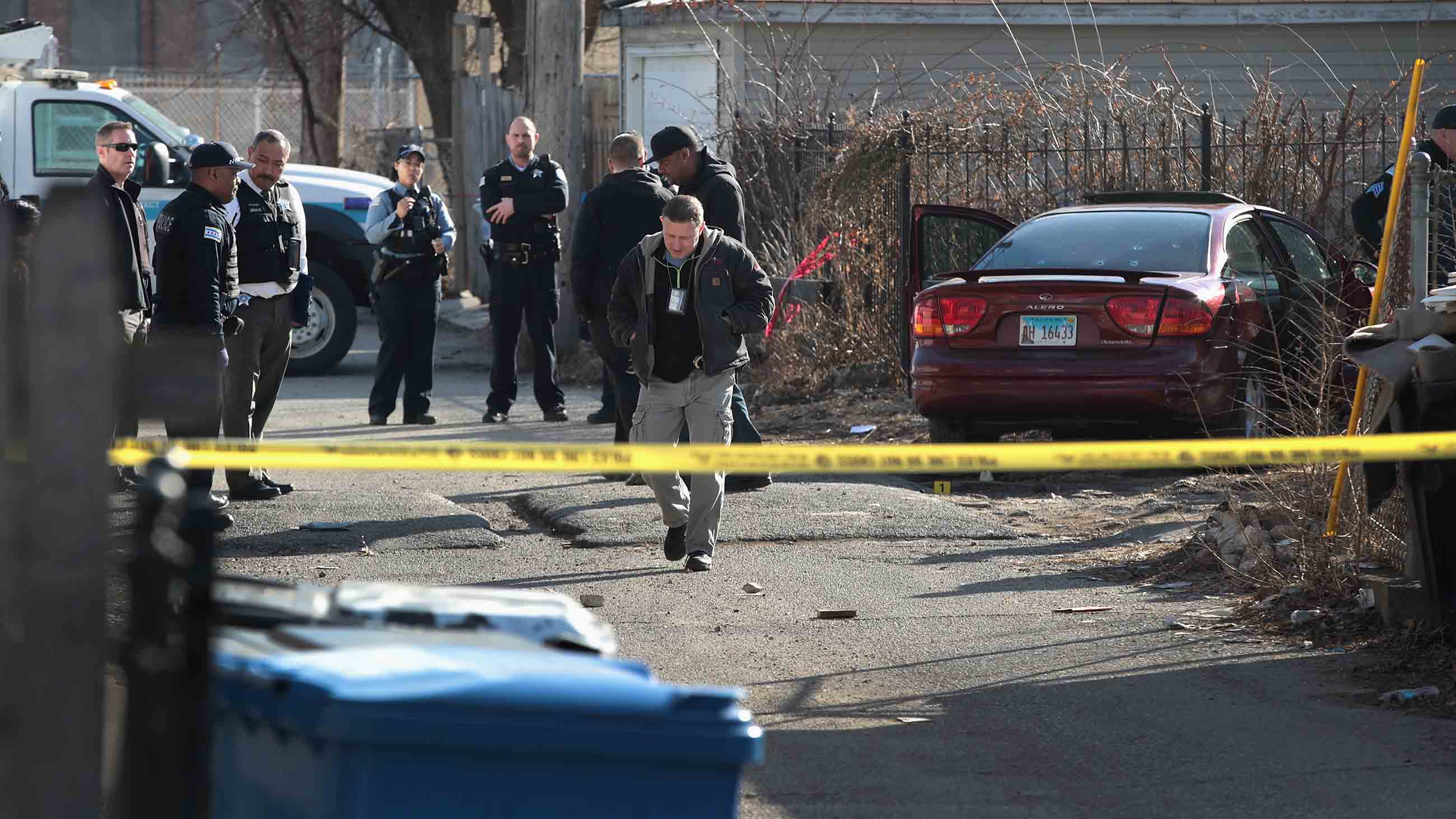On February 14, two-year-old Lavontay White Jr. was shot in the head as he sat in the back seat of a car in the North Lawndale section of Chicago. Lavontay’s uncle was also killed and three men are facing charges.
Viewed one way, the incident — which, in a macabre and modern twist, happened to have been captured on Facebook Live — might seem like just one more grim data point in a city awash in grim data points. Chicago, after all, has seen at least 865 people shot and 169 killed by gun violence so far this year. And this comes on the heels of 4,368 shootings and 764 homicides citywide in 2016, a crescendo of violence not seen since the crack cocaine wars of the 1990s.
But embedded in the tragic death of Lavontay and his uncle — and in what seems like the city’s endlessly expanding epidemic of shooters and victims — might well be the seeds of a cure. That’s the thesis, in any case, behind a growing body of research that aims to use the tools of big data and epidemiology to get a handle on, and perhaps one day begin to curb, the spread of gun violence.
Such solutions can’t come soon enough.
“Behavior is contagious,” says Gary Slutkin, a physician and epidemiologist at the University of Illinois at Chicago who has worked for decades on issues related to gun violence. “There are dopamine- and pain-mediated mechanisms that cause people to copy behavior. The brain is mediating the replication of violence in the same ways that the lungs replicate tuberculosis.”
Modern pattern analysis is revealing observations like that to be more than simple metaphor. In one recent study, published earlier this year in JAMA Internal Medicine, researchers from Harvard and Yale sought to bring to gun violence the sort of predictive algorithms that epidemiologists bring to the spread of disease. Put more simply, in communities plagued by gun violence, the scientists aimed to answer a simple question: Who’s mostly likely to get infected — that is to say, shot — next?
Building on other research that links everything from behaviors and opinions to obesity, depression, and HIV, to the concept of “social contagion” — defined as the “spread of beliefs, attitudes, and behaviors through social interactions” — Yale University sociologist Andrew Papachristos, along with Harvard Ph.D. candidates Ben Green, an applied mathematician, and Thibaut Horel, a computer scientist, decided to test whether gun violence traced a similar path of transfer through social networks. “The diffusion of gun violence might occur through person-to-person interactions,” the team wrote, “in a process akin to the epidemiological transmission of a blood-borne pathogen.”
If true, the trio posited that the spread of gun violence through direct social ties — as opposed to neighborhood-level exposure to high-crime areas — might be a critical factor in identifying individuals at high risk for being shot. In that sense, the “disease” of gun violence might be considered less like an airborne bug, and more like a virus spread through direct personal contact.
“Our central hypothesis,” the researchers wrote, “was that when someone in your network becomes a subject of gun violence, your risk of becoming a subject of gun violence temporarily increases.”
The results were striking. By analyzing and cross-referencing all gunshot incident reports and arrest records for the city of Chicago over an eight-year period — including a special focus on “co-offenders,” or people who were arrested together for any incident — the trio created a model social network that allowed them to trace flash points of gun violence “infection.” In the end, the researchers estimated that nearly two-thirds of the 11,123 shootings that occurred between 2006 and 2014 — a full 63 percent — could be connected to a discernible chain of social contagion. Further, it took about 125 days, on average, for a person exposed to an “infector” to become a victim of gun violence themselves.
“That 63 percent of the victimizations could be explained by social contagion is staggering if you consider the scale of gun violence in Chicago,” Green said in a telephone interview. “Typically, a model might consider many factors such as age, race, or criminal background to predict who would be shot next. By taking a social network model which has only one element — how many of your friends have been shot and how recently — [we were] able to make better predictions,” Green adds. “The more people you know who are shot, the more likely you are to be shot.”
This sort of data analysis is helping to confirm realities that earlier researchers like Slutkin seemed to understand intuitively years ago. Slutkin, for example, spent the late 1980s and early 1990s as an epidemiologist with the World Health Organization in Uganda, where he developed interventions that helped to reverse the country’s rampant HIV epidemic. After returning to Chicago in the 1990s — at the height of the city’s gun violence around the crack cocaine epidemic — he was struck by clusters of violence that appeared to behave much like infectious diseases.
In response, Slutkin created a program that became known as Cure Violence, an organization that employs carefully selected “interrupters” who have credentials on the street because they live in the community and may have formerly been involved in violent behavior themselves. They work to detect and short-circuit emerging conflicts with a particular emphasis on identifying and treating the highest risk individuals and changing community norms.
The program has now been replicated at more than 60 sites across the country, as well as in conflict regions the world over, from the battlefields of Iraq to the narco-violence of Honduras, and it is credited with reducing violence by as much as 70 percent in some locations. The city of Baltimore — hard-hit by the poverty, gun violence and opioid addiction portrayed in the critically acclaimed HBO series “The Wire”— modeled its “Safe Streets” program on the Cure Violence concept in 2007, and officials estimate that in 2015 alone, as many as 700 potential conflicts, the majority of which would have resulted in gun violence, were avoided.
Similar interventions have been introduced in cities like Oakland, New Haven and Chattanooga. After the introduction of New Haven’s Project Longevity, which began in November 2012, monthly gang-involved shootings dropped on average by nearly 73 percent, according to the Yale University analysis.
Of course, these programs aren’t foolproof, as the current carnage in Chicago — and across the country — makes clear. The United States still has the highest rate of gun-related deaths among other high-income countries, and gun violence accounts for 33,000 deaths each year. As data scientist David Stark told STAT in January, this makes it the 12th most common cause of death in the country. About two-thirds of these are suicides, but more than 11,000 people are gunned down each year in homicides — mostly young men of color in urban environments — and many of the concomitant factors are well-known: poverty, health disparities, housing insecurity, food insecurity, racism, sexism, and other forms of discrimination.
Meanwhile, solid research into gun violence has been persistently starved of federal funding. The Centers for Disease Control and Prevention has been prohibited since 1996 from funding studies that might “advocate or promote gun control” and the National Institutes of Health has been under similar restrictions since 2012. According to a linear regression analysis recently published in JAMA, research into the field has been underfunded by about $1.2 billion over the past decade, compared to the other 30 leading causes of death.
The funding vacuum has prompted public health researchers, who increasingly view the problem of gun violence in epidemiological terms, to take the lead in advocating for meaningful research support elsewhere. The nation’s first state-funded gun violence research center will soon be established at the University of California Firearm Violence Research Center at UC Davis. And in Chicago — a city that President Donald Trump has repeatedly demeaned as a wasteland of violence and urban decline, even as he withholds funding to address the issue — an interdisciplinary research consortium has evolved among some of the city’s leading education and medical institutions. Called the Chicago Gun Violence Research Collaborative, the coalition has begun cataloging existing research on the city’s gun violence with the goal of finding ground-level solutions.
Granular, data-driven analyses like the one undertaken by the Yale and Harvard team will almost certainly help in that regard — but none of it will have come soon enough for a two-year-old in Chicago whose uncle, police say, was a gang member himself. Born into a community already ravaged by a deadly infection, it was probably only a matter of time, epidemiologically speaking, before the contagion reached the boy.
“Lavontay wasn’t someone who made some bad decisions and lost his way or got involved in a gang conflict,” Chicago Police Superintendent Eddie Johnson told reporters in the aftermath of the shooting. “He was just a little boy with his whole life ahead of him.”
Rod McCullom reports on the intersection of science, medicine, race, sexuality, and poverty. He has written for The Atlantic, The Nation, and Scientific American, among other publications.











Comments are automatically closed one year after article publication. Archived comments are below.
Why is the disease state in this analogy becoming subject to gun violence and not perpetrating gun violence? This to me feels like victim blaming. It also seems like the more effective method would be to examine the spread of social behaviors that lead a person to commit gun violence.
I think this new direction on stopping murders–as opposed to adding endless anti-gun measures that do not stanch the flow of blood but affect only law-abiding gun owners–is terrific. If this method can stop the violence, then the “gun problem” and the sanctity of the Second Amendment cease to be an issue, because fewer and fewer people will be killed via guns. I applaud Dr. Slutkin and other like him for seeing the light and moving in the direction I had hoped for all along: target the shooters, not the tools they choose. Bravo Science!